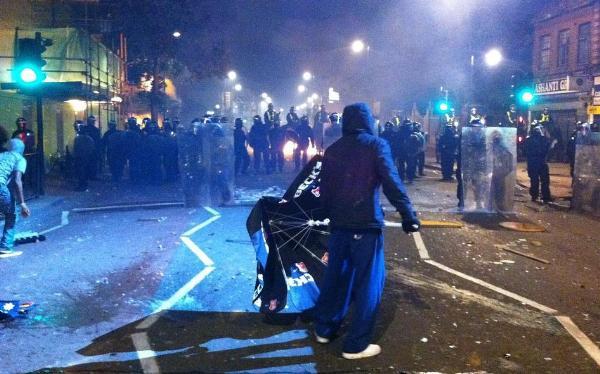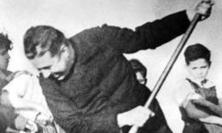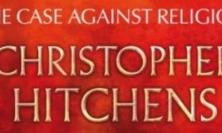In Boris Johnson’s address to the Conservative Party conference yesterday, he pledged to take steps to draw young people away from gang culture in light of August’s riots. Fr John Moffatt SJ, chaplain to a Jesuit school in the North London area where the troubles began, thinks that the way forward after this summer’s events is to listen to the stories of all of those involved in the riots – if we don’t understand one another’s narratives, how can we write a new one for our society?
I have recently moved back to South Tottenham from Oxford to join St Ignatius College, the Jesuit school in Enfield, as a teacher-chaplain. In August, I was shocked to see the violence and destruction on streets that I had known since I was a teenager and in the area where most of our pupils, parents and staff live and work. Like many others, I am trying to understand what happened and why, and where we go from here.
The statistics available on the Ministry of Justice website give a breakdown of the principle offences of the 1700 people arrested in the riots who appeared before magistrates at least once before 12 September 2011. There are many more yet to appear in court and perhaps significant numbers will be acquitted. Nevertheless there are some revealing, though perhaps not particularly surprising, trends. One, widely reported, is that in London, Greater Manchester and the West Midlands, the majority of those in front of magistrates are there for theft, burglary and robbery, rather than for violent disorder and criminal damage. However, on Merseyside and in Nottingham, where the numbers are much smaller, the offences are almost entirely of the latter kind. Another suggests that the participants in the rioting and looting were predominantly under thirty, and indeed the vast majority under twenty-five. Focusing on the London figures and looking at the patterns for the different age groups, although looting and robbery were more prevalent in all age groups, violent disorder and criminal damage were of significantly more interest to the ten to twenty year olds than they were to the older age groups. A sideways glance at the Merseyside and Nottingham figures, where we are looking almost entirely at rioters rather than looters, also shows that those involved were mostly under twenty-five.
It would be convenient to say, on the basis of numbers, that the defining narrative of the August events was one of looting, but that seems too simple. It seems much more likely that the looting was parasitic on the rioting and perhaps became more a matter of planning on the part of the older age groups as the days went on. Fighting the police, on the other hand, and setting fire to buildings suggests something much more primal and immediate, to do with anger, frustration, settling scores, an adrenalin rush, the thrill of a fight and seizing the once-in-a-generation moment to have a swing at the nearest available face of authority.
So it is that younger group of rioters that I am more interested in. In a televised interview, a small group of South London teenagers who had been involved in the riots explicitly distanced themselves from the looters. They claimed that their violence was an intentional protest about, amongst other things, their lack of prospects and exclusion from the world of the well-to-do. As they said this, they pointed to Canary Wharf on the other side of the river. Violent teenagers have political views as well. There were reports of text messages calling gangs to unite against the ‘feds’ (police) in Tottenham and elsewhere, in a telling use of a slang that has its roots in US gangster legend and belongs to the musical score of a protest narrative.
So what stories have people been telling themselves, before, during and after the event? The fact that over half of the under eighteens and four-fifths of the rest of the rioters have been in trouble with the police previously does not mean that we can therefore dismiss whatever story they tell us about why they were doing what they did. For all of us, the stories we tell ourselves set a frame for our choices. If we want to transform the quality of relations in an urban setting we need to understand the stories and why they are being told.
In an interview on BBC London, an older community representative from Tottenham, without condoning any aspect of the violence, spoke of the police receiving ‘a bloody nose’. This language, perhaps unconsciously, echoed the remark of Bernie Grant from 25 years earlier, in the wake of the Broadwater Farm riots. Here we strike a note that is deeply uncomfortable for all concerned. The killing of Mark Duggan, a resident of Broadwater Farm, has clearly awakened memories in the local and wider black community. In October 1985, Cynthia Jarrett died of a heart attack when the police forced entry into her flat. This was the trigger for the subsequent mayhem on the estate and elsewhere. She and Cherry Groce, who was shot and paralysed during a police raid in Brixton, are commemorated in a piece of artwork, ‘Boiling Point’, which features in the recent Broadwater Farm exhibition. No surprise then that at a recent public meeting in Tottenham, with local politicians and representatives of the police present, the police shooting became a dominant theme.
The related, more general issue of the ‘stop and search’ policy was also high on the agenda at the same meeting. There was a widespread perception that the police were targeting certain sections of the community unfairly, particularly the black and the young. It is important to note that the policy exists primarily to combat knife crime and has yielded significant hauls of hardware. However, the Haringey data for 2010/2011 suggests that roughly 8% of people stopped and searched were subsequently arrested, but that only 1-2% were arrested for possession of an offensive weapon. The data also indicates that proportionately nearly twice as many black people as white people were stopped. The arrest rate of those stopped is almost identical for the black and white populations (around 8%), but, put crudely, it would seem there are proportionally more innocent people with stop and search stories in the black community than in the white community.
The police representative at the meeting acknowledged that communication after the shooting of Mark Duggan had been poor, in particular with his family. It seems likely that the local police did not have sufficient information from the separate armed unit to provide answers about the incident on the day. In hindsight, this delay in communication would appear to be what allowed the peaceful protest outside Tottenham police station to be overtaken by people less interested in nonviolent demonstration and more interested in having a go at the police. This is, after all, a well-established pattern over the last few years in anti-globalisation protests. Where there are plenty of people on hand whose personal narratives celebrate violence against persons, property and the forces of authority (occasionally with an edge of political protest) the tools of instant communication do the rest.
It seems unlikely to an outside observer that armed police were pursuing Mark Duggan without having a substantial reason to do so. Whether there was a sufficient reason in a highly charged situation for him to be fired on may be an unanswerable question. However, every teacher will be familiar with the challenge to ‘prove it’ from a certain sector of their classes and indeed, at least notionally, we are all innocent until proven guilty. But on this basis, because there can now be no trial, Mark Duggan will remain an innocent victim in the minds of many, whatever subsequent enquiries may show to be the case. We all claim to want truth, but we all choose whom to believe. This is how narratives are written.
Thus is created a fundamental problem in dealing with the disaffected and dangerous in the space we share. The narrative of police unfairness, irrespective of ethnicity, allows those who in other respects regard themselves as good citizens to find common cause with people who are in varying degrees caught up in crime and violence in the area. Alongside this, local networks of extended family, friends from school, street and work, local grudges, alliances and fears generate the sort of informal, personal loyalty that an idealised rhetoric of law and order and good citizenship struggles to engage with. This, of course, applies just as much in Parliament and the City of London as in Tottenham. And in Tottenham, as in Parliament and the City of London, it makes it much more difficult for those who are best placed to bring about cultural change to do so.
This takes us to another, related narrative that equally allows otherwise respectable individuals to find common ground with those who took to the streets. The narrative of social and economic privation at one level looks ridiculous. Very little food was stolen in the looting. Everyone who rioted and looted had access to free education and free healthcare – a very different case to that of the US voices (white and black) who create the musical legend of the ghetto. However, when I asked one of our students why the rioters might have set fire to the carpet factory in Tottenham, one of the few landmark buildings in the area, he answered interestingly that it was because it was so old. It was a symbol of the lack of development and the lack of change in the area. It had never occurred to me that the building could be seen in that way, but indeed, looking later at the High Street from the bus, I recognised a more faded and tatty version of the one I used to walk down on my way to work in 1978. Unemployment in the area is high. During August, opportunities for young people aged between 12 and 18 to spend their time more creatively were limited – the free sporting opportunities locally tended to be for a couple of hours a day, or on one day a week, while the full-time activities cost money. The economic crisis is hitting and hurting here.
But proportionately few people from the area engage in criminal activity or rioted. So what tips the balance for those who choose that pathway? In our culture, economics increasingly determines our public values and a thriving economy requires lots of people to aspire to have things they do not actually need. So it is not entirely surprising that there should be people who want the latest clothes and electrical goods and want them now, and are filled with resentment because they do not have the wherewithal to get them. ‘UK PLC’ has trained its citizens to have high aspirations and at the same time created conditions in which, for many, those aspirations cannot be fulfilled by legal means. Those who choose to fulfil their aspirations illegally in a highly localised world of violence, intimidation and greed, are, within the limits of their own economic motivations, making a rational choice – one that gives to those who would otherwise be denied them, money, status and power.
The moment we start using this narrative, we realise that we are not just talking about violent and alienated young men in Tottenham. We are talking about the things that matter to any human being at any level of any society. Nor are we talking about that hardy perennial of a particular strand of politics, the eternal moral decline that besets our society. Rather we are talking about the continuing quest to establish a value and an aspiration that goes deeper than the purely economic and which every citizen can recognise as their own. This is a quest that needs to be undertaken anew in every generation. A democracy does not happen by accident and will not function well without continual care and attention. When things go wrong (as they do periodically), it does not signal a radical change in human nature, which seems to have been pretty consistent over the last three thousand years. Rather, it indicates that some of us, perhaps most of us, have taken our eyes off the ball.
So if we want our democracy to work and if we want all of us to be able to walk the streets in safety, we need a narrative of what it is to belong together, in which ‘value’ is more than just economic value. Such value needs to be visible and real in public life. We also need systems of social networking that allow more of us who recognise our stake in a stable social order to engage creatively with those who do not. In 2009 the Centre for Social Justice produced a report on tackling rising gang culture and street violence called, ‘Dying to Belong’. It anticipates many of the issues that have been highlighted after the riots, and whatever shortcomings may be found in some of its recommendations, it is surely correct to highlight the need for a subtle, systematic and long-term engagement with a key group of our younger fellow citizens that many of us prefer to ignore.
With all of this, it is important not to lose perspective. Currently, my favourite example of unrest in London (skating over the TV footage I recall from the seventies and eighties) is one from the fourteenth century, when the rioting citizens of London mobbed and beheaded the Bishop of Exeter in Cheapside, during the interregnum between Edward II and Edward III. It is a helpful reminder of exactly how good the good old days of Christendom could be and how incoherent the narrative of continual moral decline is. Side by side with this, it is important to note that although the destruction and misery caused around the country this summer was immense, there were perhaps fewer than 5000 people (five school playgrounds) involved in rioting and looting in London, and 7 million who were not. There are many men and women of goodwill, compassion and commitment in every area of civic life, who have been working and continue to work hard and selflessly to build bridges and to create conditions where young people with difficult lives can be drawn to a more human way of sharing the streets. There may be no perfect society this side of the parousia, but things can get better, and where there is goodwill, there is hope.
John Moffatt SJ is Chaplain to St Ignatius College, Enfield.






